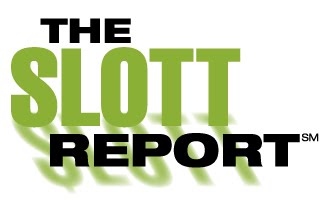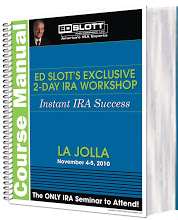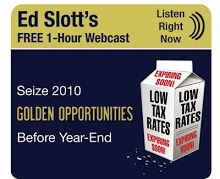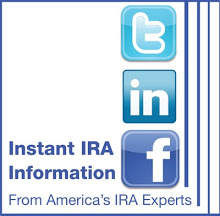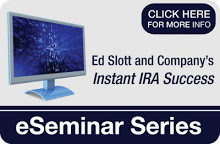Tuesday, June 30, 2009
SIMPLE IRAs - Changing Employer Contributions
IRS has a free newsletter called Employee Plans News. In the latest issue they answer a question from an employer with a SIMPLE IRA plan. (For more information on SIMPLE IRAs, see IRS Publication 560 available at http://www.irs.gov/.)
Contributions to SIMPLE IRAs come from employee salary deferrals and employer contributions. An employer can choose to make “nonelective” contributions of 2% of compensation for eligible employees. The employer must timely notify employees of the employer contribution.
The question submitted to IRS was if an employer can skip the nonelective contribution for the year or if they can terminate the plan before the end of the year. Presumably the business is having financial difficulties.
The IRS response was that the employer cannot skip the nonelective contribution for eligible employees. An employer also cannot terminate a SIMPLE plan in mid-year. IRS notes that SIMPLE IRAs are whole-calendar year plans and must continue for the entire year and pay in all promised contributions. The plan can be terminated prospectively, for the upcoming year, after giving its employees the proper notification. Employers must remember that their retirement plans come with rules and that the rules of the plan must be followed.
-By IRA Technical Consultant Beverly DeVeny and Jared Trexler
---------------------------------------------------------------------
Comment, Question, Discussion Topic on your mind? Click on the Blue Comment Link below and leave your thoughts then check back to see what other consumers and advisors think.
*Copyright 2009 Ed Slott and Company, LLC
Monday, June 29, 2009
Retirement Assets Decline in 2008
A report released recently by the Washington based Investment Company Institute shows that U. S. retirement assets were down 22% at the end of 2008 compared with year-end 2007. This news is not surprising in light of the market downturn and the high unemployment rate in 2008.
The market downturn had an impact on most aspects of the market as individual retirement accounts assets fell 24%, defined contribution plan assets were down 22%, private sector defined benefit plan assets dropped 27%, and state and local pension plan assets declined 27%. The only category that posted an increase was federal government pension assets, which gained 2% last year. These assets are invested primarily in non-marketable government securities.
The numbers also show that IRAs represent the single largest component of the U. S. retirement market.
With the decline in retirement assets in 2008, it is extremely important that individuals continue to make their annual contributions to their IRAs to help fund their retirement goals. The contribution to an IRA is based on earned income. The maximum contribution to a traditional IRA in 2009 is $5,000. If you are age 50 or older by 12/31/09 you can add an additional $1,000.
-By Jared Trexler
---------------------------------------------------------------------
Comment, Question, Discussion Topic on your mind? Click on the Blue Comment Link below and leave your thoughts then check back to see what other consumers and advisors think.
Friday, June 26, 2009
Special Slott Report Mailbag Q&A;
If I have a full time job and contribute the max to my work 401K and I also have a Schedule C part time business. What is the maximum amount I can contribute to my SEP IRA for my part time Schedule C business? I have read conflicting information. One source said I needed to reduce my SEP IRA contributions by the amount I contributed to my work 401k but another source said that was not true and I would only be limited by the 20% of self employment income rule. Can you please clarify this for me?
Thank you,
Adam Lazarus
Answer:
Assuming the two businesses are unrelated and not affiliated, you could contribute the maximum amount to your SEP IRA. The contributions to his 401(k) plan does not affect the contributions to the SEP IRA and vice versa. As a result, his SEP IRA contributions can be (up to): $49,000 or 20% of his modified net profit, whichever is less.
Have a great weekend!
New Rules for Opening or Converting to Roth IRAs
- Many people make too much money for Roths at the moment. Individuals with an adjusted gross income for 2009 of $120,000 or more can't contribute; neither can couples who make $176,000 or more.
- You aren't allowed to convert traditional IRA assets to a Roth if your household's modified adjusted gross income for 2009 is $120,000 or more. As Ed Slott points out, "A married person who files a separate tax return is prohibited from converting -- no matter how much or how little he or she makes."
- As the article states: "As part of the Tax Increase Prevention and Reconciliation Act enacted in 2006, the federal government is eliminating permanently, starting Jan. 1, the $100,000 income limit for Roth conversions, as well as the restriction on spouses who file separate tax returns."
- There is always the matter of taxes, however. Find out how to handle them and read the rest of the article by CLICKING HERE.
-By Jared Trexler
---------------------------------------------------------------------
Comment, Question, Discussion Topic on your mind? Click on the Blue Comment Link below and leave your thoughts then check back to see what other consumers and advisors think.
Thursday, June 25, 2009
The Slott Report Mailbag: June 25, 2009
We are here to answers those questions in this week's installment.
1.
I have about 43k in liquid cash in my IRA...@ .5 %. I will be 59 1/2 years. old in July. Should I start taking money out in July to avoid higher taxes in the future or should I wait to roll-over to Roth in 2010? I would really appreciate your advice in this matter.
Thank you in advance for your help,
Alberta
Answer:
If you don't need the money in your IRA to live on, withdrawing it now would not be a good idea. We generally favor Roth IRAs. If you are worried about income taxes rates going up a Roth conversion in 2009, if you qualify, or in 2010 may be appropriate for you. You will pay the taxes in the year you convert and after 5 years all withdrawals will be tax free.
2.
At age 58 I took early retirement from my company and signed up for Level income retirement. I am now approaching 62 and had planned to retire but due to the economy , I will need to keep working. Question is do I go ahead and sign up for the SS at 62 and keep drawing and working or do not sign up due to being taxed heavy due to my extra income? Some say take it now and you will still get a little increase at 66.5 and some say not to retire and just draw the company retirement and retire at 66.5. Due to the economy and losing 48% I really need the company retirement with level income and at 62 I will continue to get it signing up for SS or no difference in retirement income. I make about 54K income and with my retirement with level income it is close to 88K. How much extra in SS tax will I have to pay if I retire at 62 and keep working? Very confusing. I also have a 401K with the company which went from 110K to 72K do I need to roll this over into and IRA now.
Need some help here,
Dale Ballinger
Answer:
Deciding on when to start taking Social Security is not a simple matter and is very personal to your own situation. In your case, based on your birth date you will be entitled to full retirement benefits at age 66. To learn more and help you make an intelligent decision you can call Social Security at 800-772-1213. Social security also has a web site containing a calculator. www.socialsecurity.gov/estimator and click on "estimate Your Retirement Benefits".
3.
I'm considering converting my traditional IRA to a Roth IRA by your own advise. I will be 58, (July), my traditional IRA is valued under $30,000.00 and a 457 plan at work valued at under $10,000. My question: Should I convert or just open a Roth IRA and start saving in that? What about annuities with a Roth IRA? I have purchased your program and in your book I read something about converting above mentioned IRAs, all restrictions will be removed in 2010 and you can in 2009 convert funds and have until October 15, 2010 to undo. The income limit of $100,000, is that single or married? My survival is more depended on life insurance policies, all term in amounts of $200,000/150,000 upon spouse's death. I also have Mutual Funds, can I
change to a Roth IRA Account (amount is $4500)? Married without bliss, he can't be bothered with all this so I get no help from him although his has a pension from National Guard. His pension doesn't take federal taxes out.
Thanks,
Late Starter
Answer:
If you don't need your traditional IRA to live on generally a Roth IRA may be appropriate for you. In 2009, if you are married, filling a joint tax return your modified adjusted gross income can not exceed $100,000. In year 2010 and beyond that limit will be eliminated. In addition, if you convert in 2010 the taxes due on the conversion can be paid over two years 2011 & 2012. And yes you will have until October 15th of the following year to undo. They call this process a recharacterization.
Wednesday, June 24, 2009
Retirement Fears: An Unintended Distribution
That was the exact situation "Issac" faced when he received his RMD check - money he didn’t want so he could take advantage of the new provisions temporarily suspending RMDs for 2009. The temporary suspension would allow him to leave more money in his account this year, giving him a better opportunity to recoup some of last year’s losses.
Issac received the check and immediately got on the phone with a customer service representative at the IRA custodian (the institution that holds and keeps track of his IRA money). He wanted to send back the money, or simply, undo the process of receiving an RMD check he didn’t want.
What happened? CLICK HERE to read the rest of this Retirement Fears column and find out the steps both advisors and consumers can take when a situation like this arises.
Inherting an IRA From a Spouse
You've inherited an IRA from your spouse. What do you do now? Should you leave it as an inherited IRA or should you move it into an IRA in your own name?
Generally it is better to move the IRA into an IRA in your own name. You will not have to take any required distributions until you are 70 ½ and those distributions will be calculated using a factor from the Uniform Lifetime Table. The beneficiaries that you name on your own IRA will be able to stretch distributions over their own life expectancies at your death. The IRA is treated as though it were always your IRA funded with your dollars.
If you leave the IRA as an inherited IRA you will have to start taking required distributions when your spouse would have been 70 ½. Those distributions will be calculated using the Single Life Table, which will produce a larger annual distribution. This will deplete the account more quickly and increase the amount of income tax you must pay each year. Any beneficiaries that you name will have to continue using your life expectancy if you die after required distributions begin.
However, when you are under the age of 59 ½ when you inherit an IRA you should consider keeping it as an inherited IRA if you are going to need the funds to live on in the immediate future. Funds withdrawn from an inherited IRA are not subject to the 10% early distribution penalty but funds withdrawn from your own IRA are. Once you reach the age of 59 ½, then you can move the inherited IRA into your own IRA. There is no time limit for doing this.
-By IRA Technical Consultant Beverly DeVeny and Jared Trexler
---------------------------------------------------------------------
Comment, Question, Discussion Topic on your mind? Click on the Blue Comment Link below and leave your thoughts then check back to see what other consumers and advisors think.
*Copyright 2009 Ed Slott and Company, LLC
Tuesday, June 23, 2009
Pension Benefits and Bankruptcy
If a company files for bankruptcy-court protection, its pension assets cannot be touched by creditors to pay off debts. A pension plan is a separate entity from the company sponsoring the plan.
Under federal law, pension assets must be kept separate from an employer's business assets and held in trust or invested in an insurance contract. So, in the event of bankruptcy, the retirement funds should be secure from creditors. Some pension benefits may be insured by the federal government, with traditional defined-benefit plans protected by the Pension Benefit Guaranty Corp., a federal government corporation.
If you want to find out about protection of your pension plan you can go to the Mid-America Pension Rights Project, which is a pension counseling project. Web site elderlawofmi.org/pension_rights_project/index.html.
If you are not covered by a pension-counseling project in any way, the Federal Employee Benefits Security Administration also provides free help. www. dol.gov/ebsa and clicking on “ebsa offices.” To see if a pension has been taken over by the Pension Benefit Guaranty Corp., go to pbc.gov and click on “Pension Search Directory.”
-By IRA Technical Consultant Marvin Rotenberg and Jared Trexler
---------------------------------------------------------------------
Comment, Question, Discussion Topic on your mind? Click on the Blue Comment Link below and leave your thoughts then check back to see what other consumers and advisors think.
*Copyright 2009 Ed Slott and Company, LLC
eSeminar Series Session: 25 IRA Distribution Rules You MUST Know (Part 1)
You can still sign up for today's session and learn more about our eSeminar Series by CLICKING HERE.
Monday, June 22, 2009
Investment News: IRS shoots down new Roth ploy
A recent IRS ruling took a major step in that direction, determining that transactions entered into by a husband and wife were "substantially similar to transactions outlined in IRS Notice 2004-8.
As Slott wrote, "An error in reporting the couple's transactions, along with the transactions themselves, has left the two exposed to severe and potentially devastating penalties."
CLICK HERE to read the article in its entirety.
-By Jared Trexler
---------------------------------------------------------------------
Comment, Question, Discussion Topic on your mind? Click on the Blue Comment Link below and leave your thoughts then check back to see what other consumers and advisors think.
Wednesday, June 17, 2009
100th Post! Check Out Our Website
- Advanced multimedia and social media: Not only The Slott Report, but also Retirement Fears and we are on Tweeter!
- New and improved, easy-to-navigate shopping bag: Whether you are interested in one of our programs, webinars, books, CDs or personalized products, you can find it and purchase it in our shopping bag area.
- IRA Resources section: This is one of our new, and slightly under-utilized areas. Under this tab, you can sign up and view our FREE Monthly IRA Updates eNewsletter, all news releases, compartmentalized articles courtesy of our Google tool, a discussion forum, a place to sign up for and view Ed Slott's IRA Advisor newsletter, an FAQ section and a link to Denise Appleby's Retirement Dictionary. Did you get all of that?
Tuesday, June 16, 2009
QCDs (Qualified Charitable Distributions) in 2009
The qualified charitable distribution was first effective in 2005 and expired as of 12/31/2007. It has been extended for 2008 and 2009. Originally, it was a way for an IRA owner to take all or part of their required minimum distribution (RMD) as a distribution payable to a qualifying charity. The distribution would not be included in the account owner’s income. It was a great way to move funds that the owner was required to take and pay taxes on to a tax exempt charity and no one had to pay any income tax.
This year, 2009, Congress did away with required minimum distributions. Charitable contributions are also down this year. Both of those situations are due to the current state of the economy. However, the QCD lives on, for this year. It is still a great way for an individual with IRA assets to transfer those funds to a charity without having to pay the income tax on the distribution.
Some of the requirements are that the IRA owner must be 70 ½ at the time of the transfer, it must be a direct transfer to the charity, the QCD is capped at $100,000 per account owner per year, there is no charitable deduction, and the charitable substantiation rules apply. The benefits to the IRA owner are that taxable assets are removed from the estate at no tax cost, the gift to charity does not increase income for the year, and you get the same tax benefit whether or not you itemize deductions.
If you are over 70 ½ and are going to give money to charity anyway this year, give the funds from your IRA. For more information, contact your advisor or contact one of the Ed Slott trained advisors listed on our website.
--By IRA Technical Consultant Beverly DeVeny and Jared Trexler
---------------------------------------------------------------------
Comment, Question, Discussion Topic on your mind? Click on the Blue Comment Link below and leave your thoughts then check back to see what other consumers and advisors think.
Monday, June 15, 2009
Roth IRA Recharacterization
If you recently converted a traditional IRA to a Roth IRA you can recharacterize by October 15 of the year following the conversion. A recharacterization means reversing your Roth IRA conversion as if it never happened.
When you convert a traditional IRA to a Roth IRA you pay the income taxes based on the fair market value of the assets, your basis, at the time of conversion. In 2009 if your modified adjusted gross income (MAGI) exceeds $100,000 or you are married and filing separate tax returns you do not qualify for conversion. In 2010 both of these restrictions will be eliminated. If after you convert and then realize at the end of the calendar year your MAGI exceeds $100,000, you can recharacterize.
In addition, if the value of the assets converted have declined in value you also might want to recharacterize. By reversing the transaction you will save the income tax paid on a higher market value. If you already filed your tax return, which included the conversion, you will have to file an amended return on Form 1040 X and perhaps a state amended return.
After a recharacterization you can convert again to a Roth IRA. Once you convert and then recharacterize, you can not convert the same funds until the year after the year of conversion or more than 30 days after the recharacterization, whichever is later.
Recharacterization, a great escape hatch.
--By IRA Technical Consultant Marvin Rotenberg and Jared Trexler
---------------------------------------------------------------------
Comment, Question, Discussion Topic on your mind? Click on the Blue Comment Link below and leave your thoughts then check back to see what other consumers and advisors think.
eSeminar Series vs. 2-Day Workshop
Below are some of the main differences, which are also spelled out on our Twitter feed. So sign up here and follow America's IRA Experts in Real Time!
CE CREDITS
Simply speaking, our 2-Day IRA Workshop offers CE Credits based on your state. You can CLICK HERE for the full list of CE Credits offered at our 2-Day IRA Workshop. CE Credits are NOT offered with our eSeminar Series.
ELITE GROUP PREREQUISITE
Both the 2-Day IRA Workshop and the eSeminar Series fulfill the foundational prerequisite for membership into Ed Slott's Elite IRA Advisor Group. However, to fill the requirement with the eSeminar Series, you MUST take all 8 sessions and PASS all 8 quizzes administered at the end of those corresponding sessions.
MAKE-UP DATES FOR eSEMINAR SESSIONS
We have taken heed to the need for more eSeminar session dates, developing a continuous schedule that will give you several choices for each session running through April 2010. CLICK HERE for a full list of available dates.
SPEAKERS FOR 2-DAY WORKSHOP AND eSEMINAR SESSIONS
Ed Slott speaks for the majority of our 2-Day IRA Workshop along with our IRA Technical Consultants and several guest speakers at optional sessions. Our IRA Technical Consultants teach our eSeminar sessions and handle all Q&A.
Friday, June 12, 2009
CNNMoney.com: Fleeing An Ownership Society?
Yet, the best advisors in the business will tell you to stop running during these challenging times. With the proper planning, you can embrace it.
One key is value investing. As Ed Slott told the conglomerate of authors: In an era of shared risks, tax rates, at multi-decade lows, will definitely climb. This means that you should save in a Roth IRA or Roth 401(k).
CLICK HERE TO READ THE ENTIRE ARTICLE.
--By Jared Trexler
------------------------------------------------------------
Comment, Question, Discussion Topic on your mind? Click on the Blue Comment Link below and leave your thoughts then check back to see what other consumers and advisors think.
Thursday, June 11, 2009
Slott Report Mailbag: June 11th
We re-printed the question below so others can see many teachers or school administrators coming upon retirement are asking the same questions.
1.
Hello Ed and Associates,
I am retiring with 40 years with Columbus City Schools. I have unused vacation/sick pay (‘severance pay’), soon to have a “present value” of approx. $70,000.00. The school indicates that this sum, may be payable as tax deferred, or, in a direct, taxable ‘lump sum’ check, but that it MUST be funded into the school’s short list of ‘chosen annuity providers’. I want to receive the money into a tax deferred vehicle. I am 62 years of age.
Question: Since the money used to pay this severance is currently held in the general fund of the Treasury of the Columbus City Schools, and since the client is beyond age 59 ½ and severing employment with the school, may it be directly paid/rolled over into a Rollover IRA? Compare/contrast this to having the check received/deposited into a 403(b)...
I do not understand with clarity, what are the client/retiree’s rights (or lack thereof) to bypass deposit into a 403(b), and going directly into a Rollover IRA. It would seem to me that since this sum of money is not part of routine payroll contributions to a 403(b), then IRS Publications 571 and 590 would permit the direct funding of this severance into a rollover IRA. I wonder if the school’s Treasury department just doesn't understand the IRS rules, or am I the one who is mis-understanding something?
Thanks,
Mick Zwayer
It is very difficult yo provide an accurate answer to your question. Please pose your question to someone knowledgeable at the Columbus City School. Each of these type of plains are different so a general rule might not apply.
2.
If I leave my $2.4 MM IRA to my children 43 & 51, and my grandchildren 24,22, 20, do they take it out over their individual lifespans, or what lifespan do they take it out over. Can the older ones take it over their lifespans & the younger ones take it out earlier while their tax rates are so low?? How do I get my answer. Thank you for ALL your help which I sometimes get in the WSJ and spots on the radio.
Helen
Answer:
If your grandchildren are your primary beneficiaries of your traditional IRA at your death they can inherit your IRA balance, minus the current required minimum distribution if any. By December 31st of the year following your death they will want to split the account into thirds. This will allow each grandchild to use their own life expectancy factor, based on the age, for their required minimum distribution commencing a year after your death. The title of the split accounts should read:
Your name, deceased, date of death, for the benefit, name of grandchild.
This should be done for each account for the grandchildren.
3.
In 2010, I will be age 70 1/2, still working and own greater than 5% of my company. I realize that I will have Required Minimum Distributions from my SEP-IRA as well as my 401K accounts, but not from my Roth IRA account held longer than 5 years. My question regards contributions: In 2010, will I still be allowed to make contributions to my SEP-IRA as well as my 401-K accounts?
Thanks,
Jared
Answer:
As long as you are still working and over age 70 1/2 you can continue to contribute to employer plans, when all the contribution requirements are met, even if you are also required to take distributions from the plan.
Wednesday, June 10, 2009
Form 5498
Individuals who did certain transactions in their IRAs last year have now received their Form 5498 from the IRA custodian. These forms are informational only, but IRS also gets a copy. You need to check these forms for accuracy.
IF YOU MADE A CONTRIBUTION TO AN IRA, DID A 60-DAY ROLLOVER OF FUNDS FROM ONE RETIREMENT PLAN TO ANOTHER, DID A CONVERSION TO A ROTH IRA, OR DID A RECHARACTERIZATION, YOU SHOULD RECEIVE A FORM. I emphasize that because there are so many instances of IRA funds going into the wrong account or instructions on transfers not being followed correctly. Those errors need to be fixed as soon as possible.
If you did one of these transactions in 2008 and did not receive a Form 5498 (some custodians do send them out at the beginning of the year), call your custodian or your financial advisor. Check up on your transaction and make sure it was done and that the funds have gone into the correct type of account. If you have received a form, check to be sure the amounts listed on the form are correct. Make sure the information is in the right box, i.e. if it is a Roth transaction it is in a Roth box. Most of you, like me, will find no mistakes on your forms.
--By IRA Technical Consultant Beverly DeVeny and Jared Trexler
------------------------------------------------------------
Comment, Question, Discussion Topic on your mind? Click on the Blue Comment Link below and leave your thoughts then check back to see what other consumers and advisors think.
*Copyright 2009 Ed Slott and Company, LLC
Tuesday, June 9, 2009
eSeminar Session and Twitter
For those of you who have seen the big box on the left-hand side of the blog page, it signifies a new feature at The Slott Report.
We are continuing to enter the new information age, while also keeping a close eye on ways to improve our services to you.
You can click in the box on the link that says "FOLLOW" or go to www.twitter.com and sign up to become a twitter member and Slott Report follower.
All you need to do is enter your full name, a username, password and valid e-mail address to join. Once you are a member, type in "Ed Slott" or "The Slott Report" and click on our logo to follow our updates.
What are the advantages of following The Slott Report on Twitter?
- E-mail notifications: We will let our Elite members who follow us on Twitter know when we are sending them information so they can check their e-mail. Instantaneous Information!
- Blog Updates: Not sure when the blog is updated? Well, you can check back daily or you can follow our update timeline via Twitter.
- Workshop/Webcast Information: Have a question about one of our products or programs? If you don't have time to make a phone call, log on to our Twitter page and receive answers to frequently asked questions.
- Network: You can network with like-minded financial advisors or get connected with some of the top companies in the business who already follow The Slott Report on Twitter, including Financial Planning and Senior Market Advisor.
If you have any questions, feel free to give us a call at 215-557-7022.
--By Jared Trexler
Friday, June 5, 2009
Ed Slott Classic
Ed's new Public Television Special, Stay Rich For Life! with Ed Slott, is now airing nationwide. Contact your local Public Television Station for airings near you.
Here is a YouTube segment from Ed's first Public Broadcasting Special courtesy of KOCE. Enjoy and have a great weekend!
Thursday, June 4, 2009
Ed From Coast to Coast
Ed spoke for Morgan Stanley in Paramus, New Jersey on Tuesday, June 2nd and is speaking today for Jackson National in San Ramon, California. Tomorrow, Ed speaks again for Jackson National at the Marriott in Manhattan Beach, California.
For a complete list of Ed's speaking schedule CLICK HERE.
If your company is interested in bringing in Ed for a speaking engagement, please contact Laurin Levine at 516-536-8282.
--By Jared Trexler
eSeminar Series Reminder
CLICK HERE to register and for more information on the eSeminar Series.
--By Jared Trexler
Gain Control of Your 401(k) Plan
If your 401(k) plan permits a distribution while you are still working it is called an in-service distribution. In-service distributions allow plan participants to roll over a portion of their 401(k) assets into an IRA without penalty while allowing you to continue contributing to the 401(k) plan and matching employer contributions if the plan has that feature.
To determine if your 401(k) assets are eligible for rollover, you must review the plan document or visit the web site of the plan to review the distribution options. With more and more plans adding this option, you may find this information as an amendment to the plan.
Although all plans are different, some common types of in-service distributions include:
· Age-based: Attaining age 59 ½ on the plan's stated retirement age.
· Service-based: After five years of completed service.
Do the investments available in your 401(k) plan meet your current needs and your retirement objective? If so, then an in-service distribution may not be appropriate. If the investment options do not meet your needs or objectives then there may be an opportunity for an in-service rollover.
--By IRA Technical Consultant Marvin Rotenberg and Jared Trexler
------------------------------------------------------------
Comment, Question, Discussion Topic on your mind? Click on the Blue Comment Link below and leave your thoughts then check back to see what other consumers and advisors think.
*Copyright 2009 Ed Slott and Company, LLC
Wednesday, June 3, 2009
Retirement Fears: Living Trusts, Dying IRAs
“Sylvia” and “Robert”, a married couple of almost 50 years, waited a long time to start their financial planning. A recent health scare put their advanced age in perspective and moved a sound financial plan to the top of their priority list.
They met with an attorney and agreed on a plan to each establish their own will, power of attorneys, living wills, and living trust. The attorney reminded them - famous and costly last words - that “your living trusts only work if you fund them.” Following the orders of a trained professional, the married couple re-titled all of their assets, including both IRAs.
At tax time they soon discovered that both of their IRAs had been entirely distributed! What happened?
CLICK HERE TO FIND OUT THE MAJOR MISTAKE MADE AND HOW YOU CAN AVOID ENDING UP LIKE SYLVIA AND ROBERT.
Paying Taxes on a 2010 Roth Conversion
For 2010 conversions only, the income from the conversion will be included ratably in your income for 2011 and 2012. What that means, for example, is that if you do a conversion of $100,000, then $50,000 will be included in your 2011 income and $50,000 will be included in your 2012 income. The taxes on your 2011 income are due by April 15, 2012 and the taxes on your 2012 income are due on April 15, 2013 (although you might have to make quarterly estimated tax payments for those years).
On the surface, this seems like a pretty good deal. Keep in mind, however, that the $50,000 included in your 2011 income will be taxed at the rates in effect for 2011 and the $50,000 included in your 2012 income will be taxed at the rates in effect for 2012. If income tax rates go up significantly, you could end up paying a lot more tax than you bargained for. But, you have an interest free loan from the government from the time you do the conversion until you have to pay the tax.
As an alternative, you can make an election on your 2010 tax return to include all the income from the conversion on your 2010 return and pay the income tax at the rates that are in effect for 2010.
--By IRA Technical Consultant Beverly DeVeny and Jared Trexler
------------------------------------------------------------
Comment, Question, Discussion Topic on your mind? Click on the Blue Comment Link below and leave your thoughts then check back to see what other consumers and advisors think.
*Copyright 2009 Ed Slott and Company, LLC
Tuesday, June 2, 2009
eSeminar Series Update
If you plan on taking all 8 sessions -- you can take them 1-8, 2-1, 3-2, 4-3, 5-4, etc. In simple terms, the sessions are meant to be taken in any order, so if you missed the first two sessions you can take them during their next dates in the fall.
CLICK HERE for all session topics and dates.
If you have any other questions, please do not hesitate to give us a call at 877-337-5688 or 215-557-7022.
You can CLICK HERE for more information or click on the eSeminar Series banner on the left side of the page.
Monday, June 1, 2009
To Roth or Not To Roth
This year, 2009, you can convert from a traditional IRA to a Roth IRA if you are married and filing a joint tax return and your modified adjusted gross income (MAGI) does not exceed $100,000. If your tax filing status in 2009 is married and filing separately you are not eligible to convert to a Roth IRA. The amount being converted does not count towards your MAGI limit. Thanks to The Tax Increase Prevention and Reconciliation Act (TIPRA) passed in 2006 and commencing in 2010, the $100,000 MAGIC limit is permanently eliminated as well as the restriction of filing separately. In the year of conversion you must pay the income tax on the amount converted, the pre-tax amount converted. Once the tax is paid the money will continue to grow tax-free rather then just tax-deferred in a traditional IRA. Another major advantage of a Roth IRA is there is no required minimum distributions (RMDs) at age 70 ½ or any age for that matter. You heirs will have to take RMDs but they will be tax-free.
In 2010 everyone with a traditional IRA can convert regardless of income. In addition the IRS will let you spread the income tax due on the conversion ratably over two years 2011 & 2012. Meaning it will be included in income in 2010 & 2012. You however, will have the option to pay the income tax in 2010. Normally you would not want to pay the tax early but if you think tax rates may increase in 2011 & 2012 it may be an advantage to pay the tax in 2010. Another advantage perhaps in converting in 2010 is that asset values may be lower then they were several years ago. Therefore, the income tax due could be lower.
Word of caution. When an IRA contains both non-deductible and deductible funds, then each dollar withdrawn from the traditional IRA will contain a percentage of tax-free and taxable funds based on the percentage of after-tax funds to the entire balance in all of your IRAs. You cannot just withdraw (or convert) the nondeductible funds and pay no tax.
If you decide to convert from a traditional IRA to a Roth IRA you have an escape hatch if you change your mind. You have until October 15th of the year following the year of conversion to recharacterize the Roth conversion. A recharacterization means reversing your Roth IRA conversion as if it never happened. If the market value of the Roth conversion is much lower by October 15th of the following year, you might want to recharacterize to avoid having to pay income tax on a higher value.
--By IRA Technical Consultant Marvin Rotenberg and Jared Trexler
------------------------------------------------------------
Comment, Question, Discussion Topic on your mind? Click on the Blue Comment Link below and leave your thoughts then check back to see what other consumers and advisors think.
*Copyright 2009 Ed Slott and Company, LLC
